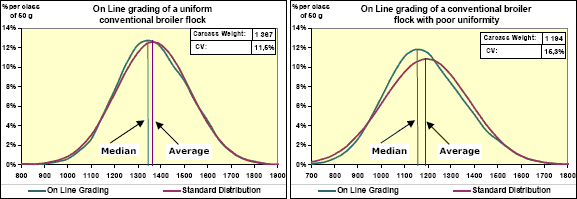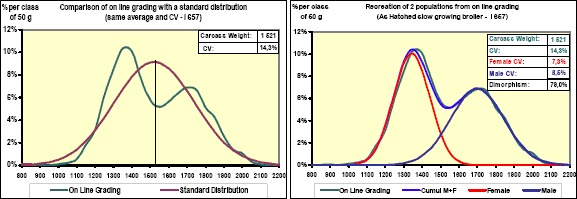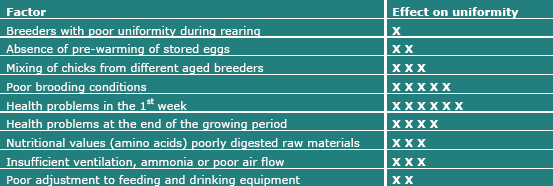



Evaluating Uniformity in Broilers - Factors Affecting Variation
By Claude Toudic, Technical Service, Hubbard Breeders - During a technical visit to a broiler farm the topic of uniformity is generally assessed visually and subjectively, as to do the job properly would require individual weighing of hundreds of broilers (in the absence of automatic weighers).The level of uniformity basically dictates the final result; poor flock uniformity goes hand in hand with delayed growth, rejects, and poor FCR. The processing plant requires uniform flocks with the correct average bodyweight (without too much deviation from the sample weights taken at the farm) to satisfy the demands of the modern distribution network.
When a broiler flock is processed a complete histogram on the range of carcass weights can be produced. The percentage of carcasses within the desired weight range is a very important measure for the processing plant.
In the end, uniformity is a good indicator of the production process; In fact all technical or health problems, starting from the day old breeder up to the broiler delivered to the processing plant, impacts the broiler uniformity at the time of slaughter.
1) Characteristics of the uniformity of a broiler flock.
Before reviewing the principal factors affecting uniformity, it is necessary to define the characteristics of a "standard" broiler population. In practice the standard method is to calculate uniformity on +/- 10%. However this calculation only gives a very partial picture of the characteristics of a population. The following graphs explain the preference for the use of "Coefficient of Variation" (C.V.) (the standard deviation divided by the average). Some on line systems calculate this automatically.
Graphs 1 compare the distribution of carcasses by on line grading classification on one side, with a "standard" population of the same average and coefficient of variation (C.V.) on the other side. One can see that the on line grading curve shifts to the left. The median (separates the on line grading weights of the flock into 2 identical sized sub-populations) is clearly inferior to the average (the sum of the weights divided by the total number of broilers). This characteristic is well known to slaughterhouse managers.
broilers with the same standard distribution curve for the
average and uniformity (C.V.).

There are several reasons that can explain the fact that the majority of the weights are systematically inferior to the average weight of the flock.
The first reason is purely statistical. It is explained by the fact that a flock of "as hatched" broilers consists of equal amounts of males and females, each with their own level of uniformity. Let's suppose, arbitrarily, that the C.V. of the two sexes is identical, the standard deviation for males is larger and therefore the percentage of birds in each division is lower. Because of this the male curve is flatter than that of the females.
The second reason, which accentuates the first, is that the C.V. of the males in reality is nearly always higher than the females, especially in poor uniform flocks. A median very inferior to the average indicates poor uniformity in the males. Graphs 2 illustrate this double phenomenon.

The ratio between the male and female weights increases with age. The weight analysis of a flock of Label broilers slaughtered at 85 days (graphs 3 below) illustrates this point nicely.

The model used to show the cumulative of the two sub-populations using on line weighing plays with the variation of the three parameters, which are dimorphism, C.V. of the males and of the females, assuming that the number of birds in two sexes is identical.
For "as hatched" flocks, the calculation of uniformity using a single criteria such as (C.V. or % at ± 10%) is not very reliable, as the birds become older, due to the predominant dimorphism on uniformity between the sexes. As an example, the above graph shows that a flock of Label broilers is made up of two very uniform populations, although the C.V. of the flock is quite high (14.3%).
The above problem does not arise in sexed broiler flocks. On the other hand, because the weight range is narrower for these flocks, errors in the pre-slaughter forecast average weight cause both commercial and logistical losses.
2) Factors of variation of uniformity in broiler flocks: Management of the breeders
Day old chick weight is proportional to the age of the breeders between 25 and 35 weeks and tends to stabilize progressively thereafter. Additionally, achieving the breeder bodyweight target with regular weekly weight gain during the first 6-8 weeks of their life, the subsequent feed management and the correct level of sexual maturity for the breed are the most important criteria that will determine the uniformity of the chicks. This requires good brooding conditions, moderate feed restriction before 6 weeks, black out rearing and sufficient feed equipment.
Incubation conditions and mixing of the chicks
Trying to achieve maximum chick uniformity by weighing the eggs from the many different aged donor flocks or by storing eggs from a few breeder flocks, does not guarantee good final flock uniformity. On the one hand, stored eggs for over 7 days and eggs from very young breeder flocks require longer incubation time than the others. The first chicks to hatch risk dehydration, waiting for the completion of the hatch. On the other hand, experience shows that mixing of the different "donor flock" micro-organisms may compromise the sanitary level of the whole hatch.
Furthermore, the absence of pre-warming the eggs, especially when they have been stored for long periods, increases the hatching time between the first and the last chicks, with the risk of dehydration of the early hatching chicks.
Rnally, mixing chicks from young breeders and those from breeders older than 35 weeks destroys uniformity. In fact, the temperature requirement of the chicks from young breeders is about 2°C higher than those from older breeder flocks. Whatever temperature is used, some of the chicks will be either under or over heated. Furthermore, the correct adjustment of the drinking and feeding equipment becomes difficult.
Brooding conditions
Inadequate brooding conditions are usually the first cause of poor uniformity. During this period the daily weight gain is considerable. During the first 10 days, the chicks increase their weight by 20% per day compared to 4% between 30 and 40 days, provided that they do not have to struggle to survive. When chicks are struggling to survive, they use the small amount of available energy to maintain vital body functions. It is always useful to remember that chicks:
- cannot regulate their body temperature before 10-15 days of age
- are stimulated to eat by light
- limit their intake when access to water or feed is difficult.
The chicks are not all equal when they arrive at the farm. Firstly, at hatch they have different maternal origins and embryonic conditions. Furthermore, because they hatch at different times, have been transported in different positions in the delivery vehicle and finally, because the living conditions are never perfectly equal throughout the whole house. It is not uncommon to observe chicks suffering from cold air currents due to a poorly insulated door in winter, huddling together to warm themselves and two meters down the house conditions are optimal. This demonstrates that their ability to find the conditions to suit them is at best limited.
It is therefore imperative to consider a batch of day old broilers at placement, as a population being made up of chicks having very different requirements, and how important it is to satisfy the needs of the weaker ones and not just to follow a routine. In this way one is certain to minimise poor uniformity.
Sanitary problems
Sanitary problems have a variable impact on uniformity. Let's take an example of highly infective Gumboro disease affecting a flock at 25 days of age. The survivors are generally uniform. The only explanation is that the birds with poor immunity are dead and that the others have all or nearly all been affected with the same intensity.
In contrast, a strong E. coli or other early bacterial infection has a very strong effect on uniformity. This is why it is essential to react quickly in the case of morbidity or suspicious mortality in the first few days of life.
Ventilation
Ammonia is well known to lower the feed intake and delay growth, but less for causing poor uniformity. An experiment was conducted in 2002 at the University of Mississippi to evaluate the effect of exposure to ammonia during the first 4 weeks on growth and uniformity at 7 weeks. The reported results speak for themselves.

Nutrition

Deficiency of lysine, as with other amino acids, induces poor uniform growth (Leclercq et al 1994). The effect is not linear (see graph to the left) and stabilizes when the requirements for growth are attained.
Poorly digested raw materials put pressure on the digestive capacity of the birds, which are not perfectly uniform to begin with, leading to further deterioration in uniformity.
3) Conclusions
Any artificial system established to assess the uniformity of non-sexed broilers and used as a quality indicator of the production process, will prove to be a delicate and laborious exercise, because of the characteristics of the different populations.

Evaluation of non-sexed broiler uniformity, is best accomplished by analysing the on line weighing information (or when on line weighing is not available organise a representative sample of carcasses) taken from some average flocks. After a period of trial necessary to calibrate this method, it can be used as a supplementary production indicator in the same way as growth rate, mortality or FCR.
Suggested causes of poor uniformity and their effect

June 2006








